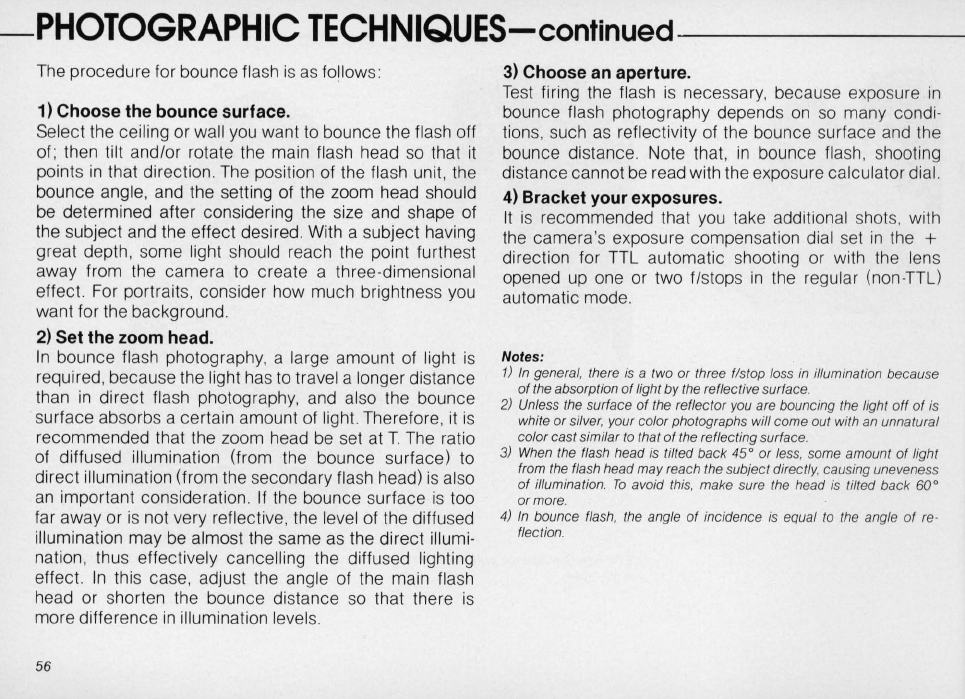
-PHOTOGRAPHIC
TECHNIQUES-confinued------
The
procedure for bounce flash
is
as
follows :
1) Choose the bounce surface.
Select the ceiling or wall
you
want
to
bounce the flash off
of ; then tilt and/or rotate the main flash head
so
that
it
pOints
in
that direction.
The
position of the flash unit, the
bounce angle, and the setting of the zoom head should
be
determined after considering the size and shape of
the subject and the effect desired. With a subject having
great depth, some light should reach the point furthest
away from the camera
to
create a three-dimensional
effect. For portraits, consider how much brightness
you
want for the background.
2) Set the zoom head.
In
bounce flash photography, a large amount of light
is
required, because the light has
to
travel a longer distance
than
in
direct flash photography, and also the bounce
surface absorbs a certain amount of light. Therefore,
it
is
recommended that the zoom head
be
set at
T.
The
ratio
of diffused illumination (from the bounce surface)
to
direct illumination (from the secondary flash head)
is
also
an
important consideration. If the bounce surface
is
too
far away or is not very reflective, the level of the diffused
illumination may
be
a
lm
ost the same
as
the direct illumi-
nation, thus effectively cancelling the diffused lighting
effect.
In
this case, adjust the angle of the main flash
head or shorten the bounce distance
so
that there
is
more difference
in
illumination level
s.
56
3) Choose an aperture.
Te
st firing the flash
is
necessary, becau
se
exposure
in
bounce flash photography depends
on
so
many condi-
tions, such
as
reflectivity of the bounce surface and the
bounce distance. Note that,
in
bounce flash , shooting
distance cannot
be
read with the exposure calculator dial.
4) Bracket your exposures_
It
is
recommended that
you
take additional shot
s,
with
the camera's exposure compensation dial
se
t
in
the +
direction for TTL
au
tomatic shooting or with the lens
opened
up
one or two f/stops
in
the
regular (non-TTL)
automatic mode.
Notes:
1)
In
general, there is a two
or
three flstop loss
in
illumination because
of
the absorption of light by
th
e reflective surface.
2)
Unle
ss
the surface
of
the reflector you are bouncing the light
off
of
is
white or silver, your color photographs will come out with
an
unnatural
color cast
si
milar to that
of
the reflecting surface.
3)
When
the
fla
sh head
is
tilted back 45° or less, some amount
of
light
from the
fla
sh head may
rea
ch the subject directly, causing uneveness
of
illumination.
To
avoid
this,
make sure the head is tilted back
60°
or more.
4)
In
bounce flash, the angle
of
incidence
is
equal to
th
e angle
of
re-
flection.


















